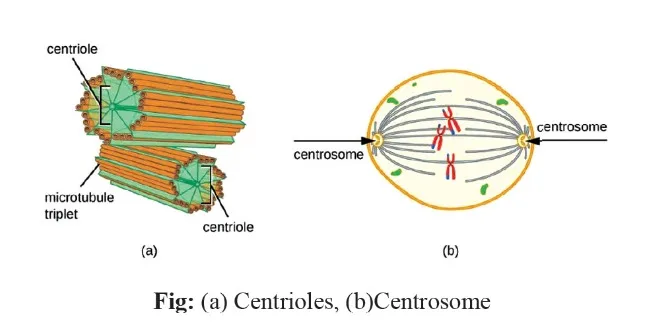
Centrosome: Cells are complex units that make up all living matter on Earth, from marine flora to domestic animals. Cells need organization and control to function properly during their growth and specialization processes. The centrosome is a key organelle that facilitates this orchestration. The centrosome, the primary microtubule-organizing centre (MTOC), and cell division regulator is critical to cellular functions. It is required for tasks such as regulating cell polarity and aiding replication during mitosis in animal cells. This article delves deeply into the centrosome's structure, functions, and localization and provides a concise overview of centrioles.
What is a Centrosome?
A centrosome facilitates cell division by orchestrating the movement of cellular components. Before division, it duplicates; during division initiation, these duplicated centrosomes migrate to opposite poles of the cell. Microtubule proteins assemble into a spindle structure between these centrosomes, separating replicated chromosomes into daughter cells.
The centrosome is a focal point for coordinating various processes during cell division. When the cell's nucleus and cytoplasm separate, it ensures proper organization. . Microtubules form the spindle, which serves as a structural framework for this separation. The centrosome, as the microtubule-organizing center, directs the arrangement of microtubules and thus controls cell division. Process.
Centrosome Diagram
The diagram labelled below shows the structure of the centrosome:

Centrosome Location
The location of the centrosome within an animal cell can change based on the stage of the cell cycle:
- Interphase (period of non-division): Throughout interphase, the centrosome is typically located close to the nucleus, often near the cell's center. Its function here is to orchestrate the arrangement of the cell's microtubule framework, which is essential for cell structure and various cellular activities.
- Mitosis (cell division): As the cell prepares to divide, the centrosome duplicates, producing two new centrosomes that migrate to opposite ends, or poles, of the cell. These centrosomes then coordinate the assembly of the mitotic spindle, which is responsible for the segregation of replicated chromosomes during cell division.
It is important to note that the specific placement of the centrosome can be influenced by factors such as cell type and the functions it performs.
Centrosome Structure
The centrosome, found in animal cells, is as important as DNA. It is made up of two perpendicular centrioles, a mother centriole and a daughter centriole, which are connected by interlinking fibers. The centrosome is a protein complex that promotes the formation of new microtubules essential for cellular structure and division. this structure is an amorphous pericentriolar matrix, pivotal in nucleating and anchoring cytoplasmic microtubules.
Each daughter cell inherits one centrosome from its parent cell during cell division, similar to how DNA replication works. actively dividing cells, it duplication initiates before the S-phase. Newly formed centrosomes play an important role in coordinating the assembly of mitotic spindles, which is required for accurate chromosome segregation. Throughout interphase, the centrosome arranges microtubules into an astral array, which aids in intracellular trafficking, cell adhesion, and polarity.
In non-dividing (post-mitotic) cells, the centrosome consists of a mature mother centriole and an immature daughter centriole.
The centrosome goes through a cyclical process consisting of four phases:
- G1 Phase: Centrosome duplication occurs.
- G2 Phase: Centrosome maturation ensues.
- Mitotic Phase: Centrosome separation occurs, aiding in proper chromosome alignment.
- Late Mitotic Phase: Chromosome disorientation occurs, completing the centrosome cycle.
Centrosome Function
Centrosomes, or the "microtubule organizing center" (MTOC), are pivotal cellular structures. Their primary role is to organize and direct the movements of microtubules and other cytoskeletal elements within the cell. The functions of Centrosome include:
Cell Shape Alteration:
- Centrosomes are essential for allowing animal cells to change shape.
- They accomplish this by orchestrating the movement of various cellular components, which eventually results in significant changes to the shape and structure of the cell membrane.
Role in Mitosis:
- Centrosomes play an important role during mitosis, the process by which a cell divides into two daughters.
- They organize microtubules, ensuring that sister chromatids are properly separated to maintain the genetic integrity of each daughter cell.
Mitosis Significance:
- Mitosis is an important stage in the cell cycle that allows for growth, development, and tissue repair.
Involvement in Phagocytosis:
- Centrosomes are also involved in other cellular processes, such as phagocytosis.
- Phagocytosis is the engulfment of foreign particles or other cells by the cell, facilitated by changes in cell membrane shape.
Centrosomes in Animal Cells
Centrosomes are essential components of animal cells, especially during division. Centrioles, part of the centrosome, duplicate during interphase in an animal cell, though the exact mechanism is unknown. Initially, the two sets of centrioles are close together, but as mitosis progresses, they separate, leaving one pair of centrioles in each new microtubule organizing center. Asters, which are star-shaped microtubule clusters, emerge from these centers.
Centrioles help to form an axis-shaped structure that runs the length of the cell as the asters migrate, which helps to constrict the cell during division. This organization helps with the separation of chromosomes later in cell division. While it helps to form the mitotic spindle, it does not directly participate in cell division in most animal cells. However, malfunctioning centrosomes in humans have been linked to conditions such as cancer, but conclusive evidence is lacking.
Centrosomes in Plant Cells
Plant cells have centrosomes like animal cells, albeit in a different structure. Plant cells without traditional centrosomes rely on structures known as microtubule organizing centers (MTOCs) to arrange microtubules. Unlike animal cells, plant cells do not typically have structures such as centrioles or spindle pole bodies, except flagellated male gametes in flowering plants.
During mitosis in plant cells, the nuclear envelope performs critical MTOC functions such as microtubule nucleation and spindle attachment, indicating an organizational strategy different from that of animal cells.
Both fungi and plants lack centrosomes, and in plant cells, the nuclear envelope serves as the primary MTOC during spindle organization and microtubule nucleation in mitosis. Despite lacking centrosomes, plant cells use various cytoskeletal structures for essential growth processes, including the preprophase band, cortical arrays, and phragmoplast, which share cytoskeletal components with animal cells.
Centrioles
Centrioles are minute structures comprised of microtubules, which are integral components of the centrosome and play a pivotal role in microtubule organization within the cell. Acting as primary units responsible for generating and anchoring microtubules, centrioles exhibit a characteristic arrangement in eukaryotic cells, typically occurring perpendicular to one another within the centrosome. Microtubules extend from each centriole, utilizing it as a point of origin, with numerous microtubules extending throughout the cell. During cellular processes, motor proteins engage with microtubules and cargo, facilitating their movement along the microtubule tracks. However, it's important to note that not all cells contain centrioles, and alternative mechanisms exist for microtubule generation.
Function of Centrioles
The Functions of Centrioles include:
- Microtubule Organization: Centrioles are central in organizing microtubules within the cell, providing a structural framework for various cellular processes.
- Intracellular Transport: They facilitate intracellular transport by anchoring microtubules that serve as tracks for motor proteins carrying cargo molecules to specific cellular destinations.
- Cell Division: During mitosis, centrioles aid in the formation of the mitotic spindle, which is essential for accurately segregating chromosomes into daughter cells.
- Replication: Centrioles undergo replication during the cell cycle, ensuring the proper distribution of centrosomes and centrioles to daughter cells, which is crucial for maintaining cellular integrity.
- Chromosome Segregation: Microtubules emanating from centrioles attach to chromosomes, aiding in their separation and ensuring the faithful distribution of genetic material during cell division.
- Structural Support: Centrioles provide structural support to the cell by serving as attachment points for microtubules, contributing to the overall stability and organization of the cytoskeleton.
Mitotic Process and Centrioles in Centrosome
During mitosis, centriole replication forms two centrosomes, each with a pair of centrioles arranged perpendicularly. Microtubules extend between these centrosomes, guiding centriole pairs to opposite cell poles. Microtubules originating from centrioles then interact with chromosomes, attaching to specialized regions known as centromeres. This attachment promotes the orderly segregation of chromosomes during cell division, facilitated by the disassembly of microtubules from centrioles and the action of motor proteins.
Structural Composition of Centrioles in Centrosome
Centrioles are structurally composed of nine sets of microtubules arranged in triplets, which give them their robustness due to the concentric arrangement of microtubules. Special proteins bind these triplets together, giving centrioles their distinctive cylindrical shape. The pericentriolar material surrounds the triplet microtubules and contains the essential molecules required for microtubule formation. Each microtubule in a triplet comprises tubulin monomers, which combine to form elongated hollow tubes resembling straws.
| NEET Exam Important Links | |
|---|---|
| NEET Biology Syllabus | NEET Biology Diagrams |
| NEET Biology MCQ | NEET Biology Chapter wise Weightage |
| NEET Biology Notes | NEET Previous Year Question papers |
Centrosome FAQs
What is the role of the centrosome?
Are centrosomes and centrioles the same?
Why is it called a centrosome?
What are other names for centrosomes?
What are centrioles and their functions?
Who discovered centrioles?










